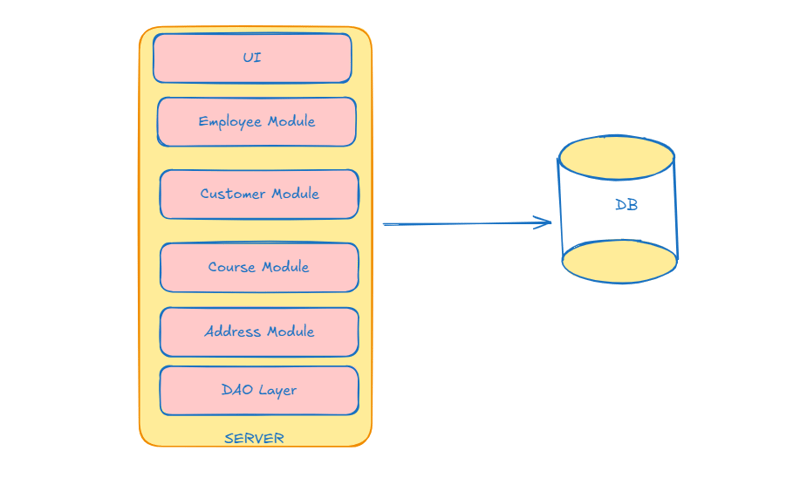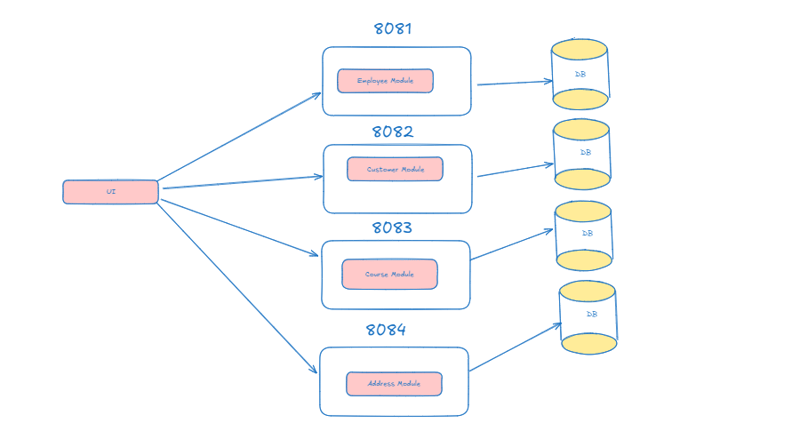
If we develop all the functionalities in single project then it is called as Monolith architecture based application.
We will package our application as a jar/war to deploy into server.
As monolith application contains all functionalities, it will become fat jar/war.
Advantages
1) Easy to develop and manage.
2) Everything is available at one place.
3) Configuration required only once.
Dis-Advantages
1) Difficult to maintain
2) Single point of Failure
3) If we perform any changes than the complete project is re-deploy and tested.
4) Developer may not be knowledge of entire modules so its harder to get started fixing issue.
5) if some module got to much load than we need to create the multiple instances of the complete application so that takes to much space because each module is tightly coupled with each other.

To overcome the problems of Monolithic, Microservices architecture came into market
Microservices is not a programming language or framework or API. Microservices is an architectural design pattern.
Microservices suggesting to develop application functionalities with loosely coupling.
In Microservices architecture we don't develop all the functionalities in single project. We will divide project functionalities into several REST APIs.
Microservices is not related to only java. Any programming language specific project can use Microservices Architecture.
Microservices is an approach using that we develop the small small services, each service is run on its own container/process/server, the services should be lightweight and independently deployable. This allows for faster development, deployment and scalability.
As you can see that employee module, customer module, address module and course module of monolith application now converted into small small service so here they are like employee service, customer service, address service and course service. and in monolith application there is single database use but in microservice application each service having its own database. and they are now dependent to each other. and each service is communication with each other throw the rest calls.

Advantages
Database Independence.
Each service is independent to each other (Loosely Coupling) so we can deploy each service independently.
if perform the any changes in any service there is no need to deploy all the service, only one service deploy single as well.
Dev working on one service doesn't requires the knowledge of entire application.
The failure of a single microservice does not impact the entire application, enhancing overall resilience.
Smaller codebases and separation of concerns make maintenance and debugging more manageable.
Due to their smaller and independent nature, individual microservices can be scaled independently based on demand, without having to scale the entire application.
Each service can be tested differently.
Disadvantages
company.name=tier3Hub
so if we want to change the name of company than in all the services we need to change the name.
Testing a microservices-based application can be more complex due to the interdependencies and interactions between services.
each service handle the some specific amount of request after that if we send more request than service is down so we need the multiple instances of the that service and to route the request in different instance of the service we need a load-balancer which balanced the request coming from the clients and routes in different instance. but writing the load-Balancer in Java is hard.
Java は、Rest API を開発するための Spring-Boot と呼ばれるフレームワークを提供し、サービスを開発している場合、Spring-Boot は自動構成、組み込みサーバーなどの多くの機能を提供するため、サーバーと Spring に Sech サービスをデプロイする必要があります。 -Boot は Tomcat サーバーを提供するため、各サービスは Tomcat の異なるポートで実行されます。たとえば、従業員サービスはポート 8080 で実行され、コース サービスはポート 8081 で実行され、各サービスには独自のサーバーがあります。

Spring-Boot の助けを借りて、迅速な開発、少ない構成、本番対応アプリケーションおよびステーター プロジェクトのための機能を提供します
Spring Framework の下には、既製のサポート マイクロサービスを提供する Spring Cloud と呼ばれるプロジェクトがあり、Spring Cloud は、マイクロサービスの共通パターンを迅速に開発するためのいくつかの共通ツールと技術を提供します。
マイクロサービス用の固定アーキテクチャはありません。開発者はプロジェクトの要件に従ってマイクロサービス アーキテクチャをカスタマイズしています。ほとんどのプロジェクトは、マイクロサービス アーキテクチャの以下のコンポーネントを使用します。
1) サービスレジストリ (Eureka サーバー)
2) サービス (REST API)
3) サービス間通信(FeginClient)
4) APIゲートウェイ
5) 管理サーバー
6) ジプキン
Java のマイクロサービスは、ソフトウェア開発へのアプローチ方法を変革し、新しいレベルの柔軟性、拡張性、回復力をもたらしました。 Java の豊富なエコシステムと Spring Boot、Micronaut などのフレームワークを組み合わせることで、最新のアプリケーションの要求に耐えられるマイクロサービスを構築するための優れた選択肢となります。
このアーキテクチャを詳しく調べてみると、従来のモノリシック アプリケーションよりもマイクロサービスの人気が高まっている理由は明らかです。これらはモジュール性と独立性を提供し、チームがサービスを個別に開発、展開、拡張できるようにします。これは、クラウドネイティブ機能がますます標準になりつつある世界では特に価値があります。ただし、その過程では、データの一貫性の確保、サービス間通信の管理、サービス全体での堅牢なセキュリティの維持などの課題も明らかになりました。
マイクロサービスを扱う Java 開発者にとって、ツールと実践方法の最新の進歩を常に最新の状態に保つことが重要です。状況は常に進化しており、適応する者は、このアーキテクチャの可能性を最大限に活用できる最適な立場に立つことができます。 Java のマイクロサービスの将来は、知識や経験を共有したいと願う開発者のコミュニティの成長によってサポートされ、フレームワークとツールが継続的に改善されているため、有望に見えます。
Java でマイクロサービスを採用することは、より回復力があり、スケーラブルで、保守しやすいアプリケーションを作成するための扉を開くことを意味します。ベスト プラクティスに従い、継続的な学習に専念することで、開発者はソフトウェア開発の新たな可能性を解き放ち、より革新的で効率的なソリューションを生み出すことができます。
The above is the detailed content of Building Scalable Microservices with Java Spring Boot: Best Practices and Techniques part -1. For more information, please follow other related articles on the PHP Chinese website!




